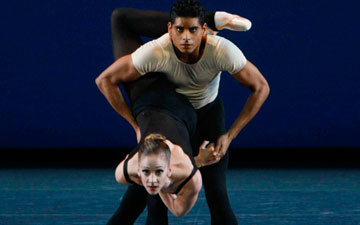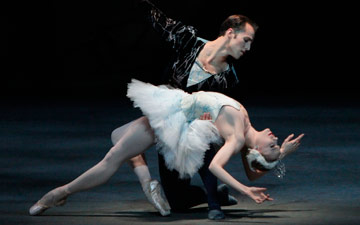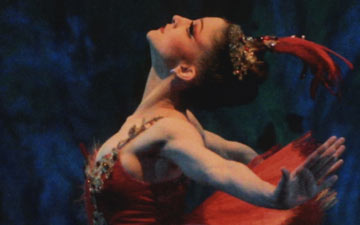
© Paul Kolnik. (Click image for larger version)
New York City Ballet
Balanchine Black & White: Concerto Barocco, Agon, The Four Temperaments
★★✰✰✰
New York, David H. Koch Theater
26 April 2018
www.nycballet.com
davidhkochtheater.com
Before launching its comprehensive Jerome Robbins tribute, City Ballet – which has yet to confirm a new director in the wake of Peter Martins’ retirement – opened its spring season with a high density program of Balanchine’s “leotard” ballets.
The troupe is still being led by the Interim Artistic Team announced in December, which includes former principal dancers Jonathan Stafford, Craig Hall, Rebecca Krohn and resident choreographer and soloist Justin Peck.
On Thursday night, with the exception of The Four Temperaments, the company’s thoughts appeared to be elsewhere. Concerto Barocco suffered from a decidedly wobbly and distracted Maria Kowroski, who looked like an inexperienced understudy thrown on at the last minute and not a veteran City Ballet dancer. By contrast, Abi Stafford proved a bright light, brimming with joy, her body filling every last breath of strings in Bach’s double violin concerto.

© Paul Kolnik. (Click image for larger version)
Balanchine demands a lot from the corps in Barocco – they never leave the stage, not even during the long, luscious, largo pas de deux, and often do the same steps as the principals. There are not many whys when it comes to Mr. B’s plotless ballets, except the music, and the corps provides key complements to both the music and the principal dancing (on Thursday night, even a welcome diversion from it). During the adagio, I sank into a meditation on the corps during a stretch of dancing that is so often reserved for principals alone. The corps isn’t a distraction but a complement, as if the harmony created by the couple is contagious, resulting in an overflowing of concordance that pours into the corps, who use it as fuel for the third and final movement, which opens with a piston-like series of piqué arabesques.
The Four Temperaments was more evenly performed than Agon or Barocco, and looked like it got more rehearsal time. Sean Suozzi gave an exceptional rendition of “Melancholic,” the first variation, his body unfurling into gestures of helplessness and even grief, before slumping over his own body like a broken puppet. But Suozzi’s passion gives him strength, and the force and attack with which he moves conveys an anger and anxiety that runs like an electrical current in the veins.

© Paul Kolnik. (Click image for larger version)
Ask la Cour was another highlight in Temperaments, performing the “Phlegmatic” variation. Moving easily between the motifs and moods asked of him, la Cour was witty, graceful and with his slight smirk, made the audience laugh several times, reacting to the music’s changes in tempo, texture and rhythm with unruffled humor. Megan LeCrone was a dominating presence in “Choleric,” announcing herself with vigor and determination. The choreography for “Sanguinic” is full of a broad athleticism, with lots of wide steps, extended développées and penchées that reach and traverse the stage, Italian pas de chats performed from side to side and partnered saut de chats. Sara Mearns and Jared Angle performed it Thursday without error but it lacked a certain sharpness. Corps members Miriam Miller and Cameron Dieck proved their mettle in the striking, angular third theme at the start of the ballet.

© Paul Kolnik. (Click image for larger version)
Agon was a bit rocky in sections, but Savannah Lowery and her partner Anthony Huxley both performed well. Lowery was delightfully playful and spot on the music in the Bransle Gay variation with its castanets providing ostinato to Stravinsky’s tantalizing ⅜ meter. Teresa Reichlen and Chase Finlay were fine in the signature pas de deux, but overall this performance of Agon lacked crispness.

















You must be logged in to post a comment.